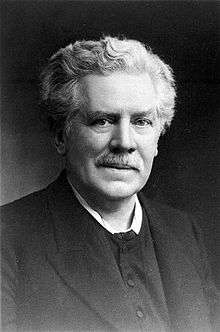Gustaf Retzius
| Gustaf Retzius | |
|---|---|
 Gustaf Retzius | |
| Born |
17 October 1842 Stockholm |
| Died | 21 July 1919 (aged 76) |
| Nationality | Swedish |
| Fields | histology |
| Alma mater |
Uppsala University Lund University |
| Known for | nervous system |
| Author abbrev. (botany) | G.Retz. |
Magnus Gustaf (or Gustav) Retzius (17 October 1842 – 21 July 1919) was a Swedish physician and anatomist who dedicated a large part of his life to researching the histology of the sense organs and nervous system.
Biography
Retzius was born in Stockholm, son of the anatomist Anders Retzius (and grandson of the naturalist and chemist Anders Jahan Retzius). He enrolled at Uppsala University in 1860, and received his medicine kandidat degree there in 1866, transferred to the Karolinska Institute (KI), where he became medicine licentiat in 1869 and completed his doctorate in medicine (Ph.D.) in 1871 at Lund University. He received an extraordinary professorship in histology at KI in 1877 and an ordinary professorship in anatomy there in 1889 (acting from 1888), but resigned in 1890 after conflicts with other members of the institute; his wealthy marriage actually allowed him to pursue his research and writing without employment.
Gustaf Retzius published more than 300 scientific works in anatomy, embryology, eugenics, craniometry, zoology and botany. He gave his name to the 60 micrometer-diameter Retzius cells in the central nervous system of the leech (Hirudo medicinalis). However, there is also a darker side of his scientific career: Gustaf Retzius is one of the fathers of the pseudoscientific race theory, "scientific racism", and one of those who tried to glorify the "Nordic race" as the highest race of mankind. He was also a journalist and the editor of the newspaper Aftonbladet (1884–87). Retzius was married to the feminist Anna Hierta, daughter of Aftonbladet's founder Lars Johan Hierta.
Gustaf Retzius was politically and socially active. Together with his wife he founded the Hierta-Retzius foundation, which is now administered by the Royal Swedish Academy of Sciences, which Retzius was a member of from 1879. The foundation has two funds, one for the promotion of biological research and the other for supporting projects of an important scientific or social nature. In 1901 Gustaf Retzius became a member of the Swedish Academy.
Notes
References
- Sjöstrand, Lars (2008). "Gustaf Retzius – great researcher and controversial cultural personality". Lakartidningen. 105 (8): 559–61. PMID 18363303.
- Hawkins, Joseph E (2005). "Sketches of otohistory. Part 6: Gustaf Retzius". Audiol. Neurootol. 10 (2): 65–68. doi:10.1159/000083361. PMID 15650297.
- Grant, G (August 1999). "Gustaf Retzius and Camillo Golgi". Journal of the history of the neurosciences. 8 (2): 151–163. doi:10.1076/jhin.8.2.151.1835. PMID 11624296.
- Grant, G (January 2000). "The histologist and anatomist Gustaf Retzius. He never received the Nobel Prize in spite of his twelve nominations". Lakartidningen. 97 (1–2): 64–70. PMID 10668335.
- Afzelius, B A (October 1995). "Gustaf Retzius and spermatology". Int. J. Dev. Biol. 39 (5): 675–85. PMID 8645550.
- HAGGQVIST, G (December 1960). "Gustaf RETZIUS". Svenska läkartidningen. 57: 3699–706. PMID 13710525.
External links
| Cultural offices | ||
|---|---|---|
| Preceded by Adolf Erik Nordenskiöld |
Swedish Academy, Seat No 12 1901-1919 |
Succeeded by Adolf Noreen |